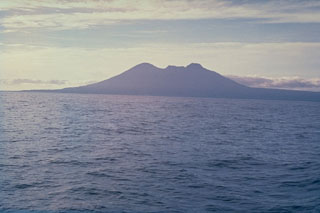Report on Long Island (Papua New Guinea) — November 1993
Bulletin of the Global Volcanism Network, vol. 18, no. 11 (November 1993)
Managing Editor: Richard Wunderman.
Long Island (Papua New Guinea) Eruption in early November, first since 1976
Please cite this report as:
Global Volcanism Program, 1993. Report on Long Island (Papua New Guinea) (Wunderman, R., ed.). Bulletin of the Global Volcanism Network, 18:11. Smithsonian Institution. https://doi.org/10.5479/si.GVP.BGVN199311-251050
Long Island
Papua New Guinea
5.358°S, 147.12°E; summit elev. 1280 m
All times are local (unless otherwise noted)
"A new eruption began . . . in early November. The first report was received on 8 November but contained few details of activity. A team from RVO overflew Long Island on 9 November and found that almost the entire body of water in the caldera lake (Lake Wisdom) had changed colour, from blue-green to orange-brown, but there was no visible eruptive activity. The source of the discoloured water could not be discerned, although it appeared to be remote from the Motmot cone in the S part of the caldera, the site of the most recent eruptions (mid-1970's). There was no sign of a recent eruption at Motmot itself.
"Volcanologists returned . . . on 11 November to carry out ground-based investigations at Motmot. While setting up a seismograph, frequent earthquakes were felt, and muffled thudding noises were heard. The noises were more noticeable on the N to NE side of Motmot, suggesting that the source of the activity might be offshore in that direction. The seismogram consisted of continuous harmonic and irregular tremor with variable amplitude corresponding with the sound effects."
Geological Summary. The broad profile of hexagonal-shaped Long Island is dominated by two steep-sided stratovolcanoes, Mount Reaumur in the north and Cerisy Peak in the south. Collapse of the basaltic-andesitic volcanic complex produced a large 10 x 12.5 km caldera, now filled by Lake Wisdom. Caldera formation occurred during at least three major explosive eruptions, about 16,000, 4000, and 300 years ago. The latter was one of the largest historical eruptions in Papua New Guinea and deposited andesitic tephra across the New Guinea highlands, prompting legends of a "Time of Darkness." Post-caldera eruptions have constructed a small cone, Motmot Island, in the south-central part of Lake Wisdom. Moderate explosive eruptions have occurred during the 20th century from vents at and near Motmot Island.
Information Contacts: I. Itikarai, and C. McKee, RVO.

